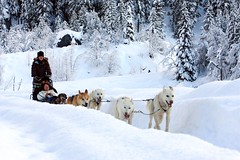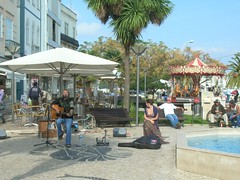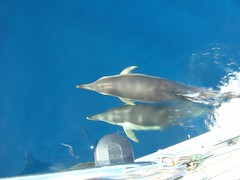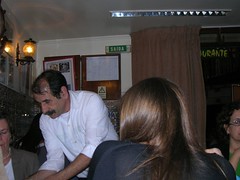Monday, 31 December 2007
Christmas in Whitler, Canada
Our daughter Jessica has been living in Canada with her friend Kate so we spent a couple of weeks skiing with them over Christmas and New Year's Eve.
Thursday, 13 December 2007
Winter in Seville - A Poem by Roger

A river the colour of coffee slides by.
And there are oranges on the trees
And girls with bare shoulders and bare knees.
And there is music everywhere.
A man who is half crazy plays bagpipes for pennies
And the beggar dances with a cardboard woman dressed in rags.
And when you sit in a street café on a chair
A thin gypsy thief sells you a lock of her hair.
And in a second floor apartment in a building on the corner by the square
Behind a balcony and a blind
Two lovers touch and find
They cannot reach other’s mind.
And the poor sleep on the tiled floor
Of the banks of the rich.
And you who have travelled so far
and for so long
See ghosts of lost loves leaning against the bar.
Yeah, winter is coming on
And before long
The sun will be gone.
Gelves Marina, Sevilla
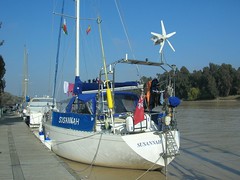 |
| Our new home until April 2008 |
Susannah on the River at Gelves
Originally uploaded by Yacht Susannah
3 - 10 December 2007
On Saturday, a boat came out which left a space on the pontoon on the river, which we grabbed as soon as possible. It is lovely to be getting some sun on the boat!
Roger and I started our Spanish classes on Monday. It was a bit of a shock to the system as we had to catch the 8.00 a.m. bus! We get to Seville just in time to throw a croissant and coffee down us before starting class at 9.15 a.m.
The school is superb. The classes are completely in Spanish, including the grammar. There are students of all nationalities - in my class there are students from Sweden, Holland, Germany and France. We have classes until 1.00 p.m. and then there are optional visits/classes. Roger and I went to the extra Phonetic class and a class about Spanish cinema on Tuesday.
Wednesday evening the Christmas lights were turned on in Seville. This year thousands of blue LED lights have been used, which looks beautiful but also uses less electricity. It took three days to build a crib scene in the Plaza Nuevo, using real rocks and cement. Miniature oranges were used as part of the decoration instead of holy. We met up with people from the school in a small Flamenco club, La Casa de la Memoria, which was superb. I recognised the club from the same one Roger and I had gone to a few years ago when we were in Seville.
Thursday was a fiesta day, so there were no classes, but the school had arranged a visit to Ronda. Roger and I both felt we got more from this trip than when we went on our own a few years ago, as we had two Spanish speaking guides from the school. Many of the houses are built on the edge of a precipice and the view is spectacular. Apparently, quite a few people come to Ronda to commit suicide by jumping off the edge!
We crossed over the New Bridge, which was built in the 18th century and spans the gorge between the new and old towns. We then visited the fantastic Arab baths which were built in the 8th century, and are amongst the best preserved in Spain. We had lunch outside in the main square as it was lovely and warm in about 23 degrees, before visiting the famous Bullring. Ronda’s bullring was built in 1784 and is the oldest preserved one in Spain. Inside the corridors there is a permanent exhibition about bullfighting, including the usual photographs of Ernest Hemingway.
 |
| Flamenco at Casa de la Memoria |
 |
| Ronda with the Spanish Class |
Chipiona to Gelves, Seville - 54 Miles; Total trip from Swansea 1970 Miles
After the heavy rains on Tuesday, the river was like a brown stew and we had to be careful not to hit any of the floating debris. We saw herons, cormorants, storks and an eagle. We also saw horses and bulls by the river banks. There was a nasty moment when a lot of weed wraped itself round the prop. We put the engine into reverse and then forward a few times which luckily seemed to free it.
There was so much debris and silt in the river that our echo-sounder started giving a false return. Later a Swiss boat, coming upriver behind us, radioed and asked us to pilot them up river as their echo-sounder had packed up. We explained that we were in the same boat so to speak and they overtook us and pressed on.
As we were nearing Gelves the Swiss boat passed us heading back downriver somewhat unnerved by low power lines just before the marina – the clearance height given on the chart was 16.5 meters above mean high water springs (note: since January 2007 charted heights are above HATS; the highest astronomical tide). We were at this time about two hours before high water and one day away from springs! In addition, the previous days flooding in Sevilla would have raised the water level by an unknown extent. We didn’t know the height of our mast, but the Swiss boat was 20 meters and he had decided not to risk it. The lines sagged in the middle of the river so we tried to pass as close to one bank as we dared – the non-functioning echo-sounder made this a rather risky undertaking. As we went under it looked very much like we were going to hit the lines and in a last minute loss of confidence we put the engine in reverse however this change of heart proved to be too late; the tide took us through – luckily we made it!
The man in the marina was surprised when we said we had booked and indicated there wasn’t any room as everyone who had been anchored in the river had come in because of the bad weather on Tuesday. We said we had rang several times to confirm and in the end he found us a place tucked in the corner of the marina. It turns out this was the berth where Gwyneth Lewis, the Welsh Poet Lauriat had when she was in Gelves. There was a submerged boat we had to squeeze past which made it very tight getting in. When the tide went out, there was a lot more of the submerged boat than we had first thought! Apparently it sank in the summer but there are arguments over who pays to remove it – the insurance company or the marina.
We met Stuart and Sue, who have been living on their boat in Gelves for about 5 years. They had been at anchor for the past four months but their anchor dragged on Thursday when there was an 8 knot tide running because of the heavy rain on Tuesday, so they had to come into the marina. Stuart teaches English and Sue looks after a Spanish family’s children. We then chatted to Linda and John who are staying for the winter, and Diana who is 76 and lives on her boat in the yard. Roger and I had something to eat and met up with everyone in the evening at the bar.
Diesel: 79.59 euros, 1.05 per litre;
Marina: 1960 euros for 5 months
 |
| Fishing vessel on the Guadalquivir |
Tuesday, 20 November 2007
Chipiona, Spain
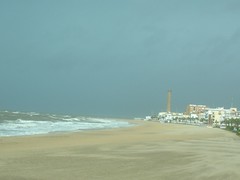 |
| Force 7! |
Force 7!
Originally uploaded by Yacht Susannah
Chipiona is in a bay near the Rio Guadalquivir, which is the river we will need to navigate in order to get to Seville. We are staying here until Friday until the weather improves and the tides are right for getting up the river. It is 55 miles to Seville, and it is important to set off about an hour before low water in order to arrive on one tide.
The weather on Tuesday was very bad with a strong Force 7 and thunder and lightning. The Province of Seville had over 110 litres of rain per square meter in 24 hours – the wettest on record – and many houses and businesses were flooded. In one area, a tornado had destroyed 5 houses and uprooted over 300 trees! We were extremely pleased to be tucked up safely in the marina!
We wandered around Chipiona and it was wonderful to see the trees full of oranges. Roger tried one that had fallen on the ground, but said it was very bitter and decided road kill did not taste so good! We were able to buy a chart of the river which, aside from merchant shipping, appears relatively free of hazards. There are two restaurants in the Marina. Pacos is recommended in the Pilot Book but was closed for November, so we went to the other one. The food was reasonable and the translations in their menu I found very funny – ‘cuttlefish on a sink’ should have read ‘cuttlefish in it’s ink’! while Roger was somewhat amused by the ‘aged cheese’.
The 226 foot lighthouse in Chipiona is the tallest in Spain and the third highest in the world. Guided visits are held every Thursday, so Roger and I booked. We turned up at the appointed time with about a dozen Spanish visitors, but were told we could not go up as it was raining. Although there was only a fine drizzle, the lightening conductor is at the top of the lighthouse and they were concerned about the possibility of a lightening strike wiping out a few tourists. Such health and safety concerns almost made one feel one was back in Britain!
Ayamonte, Portugal to Chipiona, Spain - 57 Miles
 |
| Chipiona |
We had another dawn start but because Spain is an hour in front of Portugal, we were able to leave at 7.30 a.m. Spanish time. We were worried about the weather as Navtex was giving a heavy wave warning! The sea state was going to increase from smooth to slight, to moderate and rough. Luckily the wind was in our favour and we managed to sail nearly all the way at about 6.5 knots. We made very good time and arrived in Chipiona about 5 p.m.
Marina: 12.45 euros
Portimao to Ayamonte - 64 Miles
We had intended taking the next part of our trip to Seville slowly, doing about 20 – 30 miles a day, but the forecast for Tuesday and Wednesday is very bad with 4.5 metre swells and a Force 6, so we decided to push on as quickly as possible. We left Portimao about 6.30 a.m. in the dark.
It was a beautiful warm day when the sun came up with a flat sea, so we motor-sailed the whole way and arrived in Ayamonte about 6.00 p.m. in the dusk. Ayamonte is on the Rio Guadiana which is the border between Portugal and Spain.
Marina: 11.91 euros
Lagos to Portimao - 9 Miles
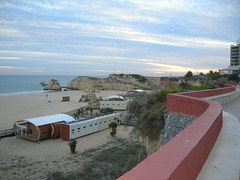 |
| Praia de Rocha, Portimao |
Roger and I set off about 10.00 a.m. for Villamoura, about 25 miles away, but there was a 2 metre swell and a Force 5 on the nose which made the sea very uncomfortable and Susannah was only making about 3.5 knots. We decided to divert to Portimao and arrived about 1 p.m. We met up with Barbara and Geoff on Eliza J who are here for the winter.
We had a walk around Praia de Rocha, which seems rather run down compared to Lagos and a lot of the cafes were closed for the winter.
Marina: 16.14 euros
WiFi: 3 euros an hour
SATURDAY 17 NOVEMBER 2007
PORTIMAO
The forecast was the same as yesterday, so we decided to stay in Portimao until tomorrow. We had a leisurely start to the day and Barbara came for coffee on her own, as Geoff has got a bad cold. Roger and I cycled to the town after lunch and went out for a meal in the evening.
Friday, 16 November 2007
Walk to Sagres
 |
| Cliffs near Sagres |
MONDAY 12 NOVEMBER 2007
Many sailors from Swansea seem to sail as far as Lagos and stay for years – it is known as ‘The Velcro Port’. Because of the large number of permanent residents, there are various activities arranged by and for the Marina inhabitants such as an Internet Self Help Group, weekly talks on matters of interest to sailors, trips to local sites and weekly organised walks. Roger was still feeling ill with his cold and Tudor was feeling ill because of his hangover, so Barbara and I joined the walk to Sagres.
We caught the bus to Sagres and walked to the fort built in the 17th century on the site of an earlier fort built by Henry the Navigator. However, most museums in Portugal are closed on Mondays, and this was no exception. We had a lovely walk along the cliffs looking down to a clear, blue sea where we had our picnic. We passed the small, picturesque harbour of Baleeira and completed the round trip back in Sagres, where we had a coffee until the bus came. On the way back, the bus had a blow out so we had to wait for another bus to pick us up.
In the evening, I joined everyone for dinner on Blaze II.
 |
| Dinner on Blaze II, 64 foot catamaran |
Thursday, 15 November 2007
Lagos
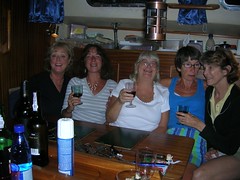 |
| Meeting up with old friends |
Vivienne, Sheila, Sandra, Barbara and Carol
Originally uploaded by Yacht Susannah
SUNDAY 11 NOVEMBER 2007
Dinner on 'Yooannmee', Barbara and Tudor's boat
Roger and I are still suffering with our colds, so we had a lazy day. In the evening I went for dinner on Barbara and Tudor’s boat where I met some of the Marina community. Sandra and Dave sailed from Swansea 9 nine years ago and now live here in their apartment. Brian and Vivienne are from Scotland and live in an apartment near Sandra and Dave. They own Yellowbird, a racing boat which is berthed in Lagos and Sticky Paws, a very large catamaran, originally built in Lagos by a couple from Swansea, and at present in Scotland. Carol and Roy are from California and are crewing BlazeII, a 64ft catamaran.
Lagos
FRIDAY 9 2007
A boat called Inshala was berthed in front of us on the waiting pontoon which was flying the Welsh flag. We spoke to the owner, Colin, and then realised Richard, who had taught sailing with Roger, was also on the boat! Rainbow Dreamer, Roger Bennet’s boat from Swansea was berthed in front of Inshala, making three Swansea boats in a row!
We found our berth and a Dutch couple, Jaab and Diana on Kiara, who Roger had met in Ribadesella, were berthed opposite us. We had showers and went to meet up with our friends from Swansea Yacht Club, Tudor and Barbara, who are spending most of the winter here on their boat Yooannme.
Later on we met Barbara and Tudor in the South Bar to use the free internet access and went to Roger’s favourite Chinese Restaurant which is in the Marina.
SATURDAY 10 NOVEMBER 2007
Roger and I wandered around Lagos after a leisurely breakfast in a café and visited the 17th century fortress on the seafront and the site of Europe’s first slave market where slaves were brought from the Sahara in 1441.
Sines to Lagos - 78 Miles (1785 Miles in Total)
THURSDAY 8 NOVEMBER 2007
We left Sines about 6.30 a.m. as we had a lot of miles to cover. There was a flat sea and no wind so we motor-sailed. It was very warm and dolphins came to play several times, criss-crossing in front of our bow. The wind picked up about 2 p.m. enabling us to increase our speed. The sun was very low in the sky when we passed Cap Sao Vicente which gave the cliffs a lovely orange glow and we watched the gannets crash dive into the sea. Christopher Columbus was shipwrecked near here in a sea battle.
Cap Sao Vicente in the most westerly point in Europe and we are now about 875 miles south of Swansea having sailed about 1785 miles in total. It was a relief to get around this point as there is very little shelter on the whole of the western side of Portugal and in strong winds they sometimes shut the few available harbours.
We had a night entry into Lagos in about a Force 5 and berthed on the waiting pontoon about 8 p.m.
Marina: 112 euros for a week
WiFi: Free in South Bar and Marina de Lagos bar
Saturday, 10 November 2007
Lisbon
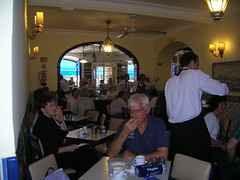 |
| Sampling the Pasteis de Nata at Antigua Confeitaria de Belem |
Still in search of the best Pasteis de Nata, we caught the train to the Belem area of Lisbon and went straight to Antiga Confeitaria de Belem so that Roger could judge whether this really was the place that made the best Pasteis de Nata. He had to have two, just to make sure, but in his humble opinion, they definitely make the best custard tart.
We then caught the tram to the centre of Lisbon and went up the Elevador de Santa Justa which was built at the turn of the century by an apprentice of Alexandre Gustave Eiffel. The walkway at the top links with the Bairro Alto. A spiral staircase leads to a café at the very top with spectacular views of Lisbon.
We finished our visit by having lunch in the Brasileira Café in the Chiado district
Sintra
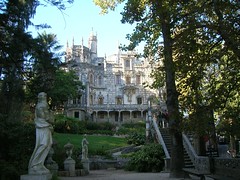 |
| Palace de Rigaleira |
We caught the bus to Sintra, which is a village in the hills where the Kings of Portugal would go as a summer retreat. The town was recognized as a UNESCO World Heritage site in 1995 and there is so much to see there that it would take at least a week! Having had such a tiring day yesterday we limited ourselves to just a couple of places to visit. The first was to the Palacio Nacional de Sintra, which was used as the royal summer palace until the 1880s. The Sala de Brasoes was the highlight, with a beautiful ceiling decorated with the coats of arms of 72 noble Portuguese families, and the walls lined with 18th century tiles.
After a leisurely lunch we visited the Quinta da Regaleira, which was built between 1904 and 1910 for an eccentric millionaire, Antonio Augusto Carvalho Moneiro. The chief architect was Luigi Manini, who had been an Italian scenery designer and the house, gardens and other buildings create a magical wonderland of eclectic architectural styles and weird symbolic sculptures.
Anna and Ken from Broadsword came round in the evening and we got through a few bottles of wine.
Roger's Review of the Fado Evening in Lisbon
According to our guide book Fado, like blues, is a musical form which “owes much to the concept known as saudade, meaning a longing both for what has been lost, and for what has never been attained … “. This sounded like it could be a fun evening so we decided, while in Lisbon, the home of Fado, to go to a performance. Our guide book counselled us to avoid the slick tourist presentations and to seek out fado vadio, itinerant fado in humbler restaurants and bars in order to enjoy a more authentic musical experience.
We found an area of downtown Lisbon where the narrow winding streets were full of small family run restaurants all offering an evening of fado. The problem of choosing which restaurant to go to was solved by the restaurant choosing us. Outside the establishment the grandfather of the family, a charming man of some eighty years, accosted passersby and without the benefit of a common language, but with great curtesy and politeness firmly ushered them through the door. Indeed, during the course of what proved to be a long evening we only saw one couple who wandered in voluntarily. They left shortly afterwards. Somewhat surprisingly the staff seemed to be acquired in the same way; a young girl was accosted and, rather reluctantly I thought, propelled into the restaurant where she donned apron and proceeded to wait on table.
Without doubt the star turn of the evening was the waiter; a character who bore more than a passing resemblance, both physically and in terms of competence, to Manuel in Fawlty Towers. He muddled orders, forgot things and generally created chaos with great energy and good humour simultaneously looking worried to death. However, if he was Manuel the young girl proved to be Polly; calmly and with great resourcefulness sorting out all the problems.
In due course the Fado musicians arrived, or at least two of them did; the singers, two male and one female turned out to be none other than the husband and wife who owned the restaurant and the grandfather figure who we had met outside. Indeed, the old man proved equally skillfull in propelling people through the door when working inside as when working outside. It was during one of his numbers that Sheila, who is generally not one to cut and run, lent across the table and with a note of desperation in her voice asked whether we had to stay till the very end.
The instrumentalists consisted of a guitarist and someone who played a strange 12 string sort of mandolin called the English Guitar which had its own unique Fado tuning. These two musicians were very skilled and quite enjoyable to listen to. Unfortunately, the same could not be said of the vocalists, although they would have perhaps done better to have concentrated on the job in hand instead of multi-tasking. The middle-aged male singer obviously aspired to be an electrician – he changed the light bulb in the ladies toilet and fiddled with the fuse box inbetween numbers. His wife, who made a noise somewhat reminiscent of a cat having one of its legs amputated with a blunt saw, multi-tasked by passing plates of food, drinks and lighting candles (perhaps she suspected that her husband’s electrical skills matched his musical ability) on tables. The high point of her performance for me was when the obese, toothless, cook attempted to squeeze past my chair all too briefly depositing one huge breast in each of my ears; mercifully drowning out the Fado singing. I would not say that the male vocalist was hopeless; I think that if he had the right tuition and really applied himself in several years time he might make a reasonably competent electrician.
Fortunately, the performance was presented in twenty minute musical blocks after which there was a twenty minute recovery break (necessary for the audience rather than for the performers). However, we noticed that one of the instrumentalists would take his mandolin and rush off up the street during these breaks. One could be forgiven for forming the suspicion that he was simultaneously performing in another nearby restaurant. This reminded me of when I worked for a college. A fellow lecturer had perfected the technique of teaching two classes (different subjects) at the same time, thus fulfilling his contractual teaching obligations in half the required time. He would say a few words of wisdom in front of one class and then leave them to ponder the matter while he sprinted to his other class (often located on a different floor of the same building and sometimes even in a different building) where he somewhat breathlessly gave them something to think about before sprinting back. It always surprised me that given the rather top heavy management structure in colleges (the lecturer in question had above him a senior lecturer, a principal lecturer, a head of school, an assistant dean, a dean, several assistant principals, a vice-principal and rather like the Lord Chancellor, in Dickens Bleak House, a principal ultimately presiding over this mountain of self-important incompetency) that no-one apparantely thought that this double teaching was in anyway unfair to either students or taxpayers.
But I digress; back to the fado evening. During one of the breaks the male vocalist/electrician visited each table and attempted to sell a CD of his greatest Fado hits; he was as successful as John Prescott would be trying to recruit members for weight watchers. Like most other people in the restaurant we made an early exit.
Well we certainly achieved what we set out to do i.e. avoid a slick performance and the evening did leave me with a longing for what has never been attained.
Lisbon
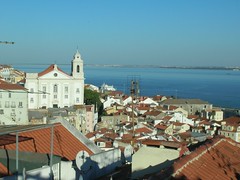 |
| Lisbon |
We caught the train into Lisbon – a 50 minute journey and went to the Museu Nacional de Arte Antiga. We walked into the Alfama district and after lunch visited the Casa do Fado which has an exhibition of the history of Fado music. By now we were very tired so after failing to find some green area to lay down in, we found a bench at the Miradouro de Santa Luzia, which has spectacular views over Lisbon. We had booked a restaurant with Fado at 8 p.m. but had a lot of time to wait, so we went to a couple of bars.
Peniche to Cascais - 45 Miles
 |
| Leaving Peniche at dawn |
We left about 7.00 a.m. and Broadsword had already left. It was a lovely warm day and we motor-sailed the whole way in a flat sea. We arrived about 2.30 p.m. and got diesel, and Broadsword arrived just after us. Roger recognized the people on Sheer Fantasy, Diane and Bob, who he had met in Ribadesella, so we went and had a drink with them. Later we wondered around Cascais and had a meal.
Nazare to Peniche - 25 Miles
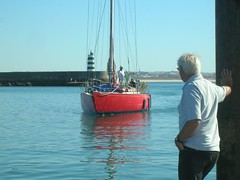 |
| Broadsword arriving in Peniche |
We left about 8.30 a.m. and motor-sailed most of the way as there was hardly any wind, arriving about 1 p.m. The customs official was on the dock as we arrived ready to do the necessary paperwork. He told us the Marina office was closed as it was a holiday, and when we asked him how to pay, he said unless anyone comes and asks, don’t bother! I asked if he was likely to chase us for payment, and he said the last police launch had already left. This was quite a change from the officious marina at Nazare where there is a blacklist of non-payers!
We had lunch and Ken and Anna arrived on Broadsword about an hour later. We had drinks on their boat and then we all went into town and had a coffee, and Roger had a Pasteis de Nata – very good, but the Oporto one is still the best so far.
Peniche is on a peninsular and partly enclosed by 16th century walls. It has a very large fishing fleet, but the town is quite small. The 16th century fort was still used as a prison during the Salazar dictatorship, and the communist leader Alvaro Cunhal escaped from there in 1960.
Nazare
 |
| Nazare - View from Sitio |
The Harbour Master made himself known to us – Captain Hadley, who comes from the Isle of Man, and we had a chat to the couple on Broadsword. After a shower and breakfast, we headed into town and the internet café, where Roger sampled another custard slice. This one came second to the one in Oporto. Although obviously a holiday place in the summer, Nazare still retains its charm as a fishing village, with the local women wearing headscarves, shawls, aprons and interesting socks!
We had a Menu del Da and then went on the funicular up to the village of Sitio, which seems to cling to the cliff face. The women wear several petticoats under their skirts and woollen socks. It was a lovely warm afternoon, but back at the boat the cool northerly was blowing.
The Harbour Master had told us that a lot of the marinas were already full for the winter, so we had better book our place in Gelves, Seville as soon as possible. When I rang, I was told they were having a new pontoon fitted and didn’t know if it would be ready in time and they may not have space. I explained that I had tried to book last April and was told to ring in October, and we would have a problem if they now said they couldn’t accommodate us. After a phone call to her manager, she said she could book us in. It so happens her name is Susannah!
Wednesday, 31 October 2007
Figuera de Foz to Nazare - 38 Miles
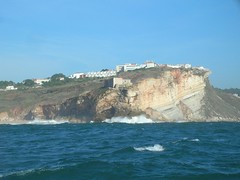 |
| Cliffs at Nazare |
We had showers before leaving at 9.15 a.m. and Roger put his back out putting his socks on. The wind had died down but there was about a 3 metre swell, which made the trip a little rolly to start. The wind then strengthened from behind which stiffened the boat and we were managing about 7 knots with full main and genoa. By the time we reached Nazare the wind was about Force 5-6, with a large swell running into the harbour.
A customs official arrived immediately for paperwork before I could even get out of my wet clothes. However, he was very friendly and very handsome – which always helps! We were finishing off securing the boat, when a policeman turned up to look at our passports. We then went to the Marina to complete the paperwork there with the marina manager. You might be forgiven for thinking that three people to do a job which in the UK would be done by one is a bit excessive. However, we learnt that there is also a (English) Harbour Master who was yet to appear.
There are quite a few English, Welsh and Irish boats here, including the Irish couple from Arklow on Broadsword who we’d met in Pavoa de Varzim, and we chatted to a couple from Conwy who have been living on their boat about four years.
We had a quite evening on board, nursing our injuries.
Marina: 14.50, free showers
Aveiro to Figuera de Foz - 39 Miles
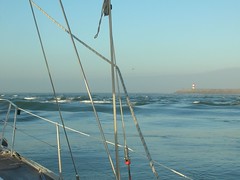 |
| Leaving Ria Aveiro |
Another early start at 7.15 to make the tide and we arrived at Figuera de Foz about 2 p.m. We were greeted by the Customs official who wanted us to complete paperwork before finding a berth. By the time we had done this, filled with diesel and done the paperwork with the Marina, it was 3 p.m. so we went in search of lunch. Because we had the usual bottle of wine, the rest of the day was spent having a long siesta. It was quite windy in the night.
Marina: 17.50, free showers
Diesel: 1.19 euros per litre, 67.79
Pavoa de Varzim to Aveiro - 50 Miles
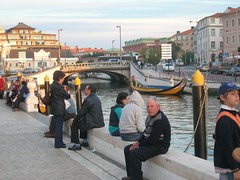 |
| Bridge in Aveiro |
 |
| Susannah moored by the salt pans in Aveiro |
The clocks went back today and because we had a long way to go before it got dark, we had to set off at first light, about 7.00 a.m. We sailed and motor-sailed to Averio and made good time, arriving at the mouth of the Ria Aveiro about 3 p.m., an hour and a half before high water. There was about a 4.5 knot tide going up the river, which wasn’t mentioned in the Pilot Book – we were actually doing about 9.5 over the ground!
Aveiro was once a great sea port and there is still a lot of large shipping which makes the area seem industrialised with docks most of the 6 miles up to the town of Aveiro.
The salt pans of Aveiro were mentioned in a will of 959 A.D. and the town was extremely wealthy from the salt and bacalhoeiros who fished for cod off Newfoundland, but in 1575 a storm caused a sand bar to block the entrance to the harbour, creating a large lagoon area stretching about 30 miles north and 10 miles east.
We followed the buoyed channel to near Aveiro. According to the Pilot Book there is a floating pontoon where boats can moor or wait for the lock to open at high tide and enter the canal. The pontoon was extremely small and a 18ft boat was already moored there. We had no choice but to moor alongside this small boat, which was quite difficult in a fast flowing tide. A new bridge is being built over the lock and it was obvious it would not be opening for a quite a while! Projected finish date for the project was August 2007! There is a large area of salt pans near the pontoon and information about how the salt is made.
Roger didn’t feel it was safe to leave the boat, so I walked the 10 minutes to town, which was worth the walk. Aveiro is known as the little Venice of Portugal because of the canals and bridges criss-crossing the town, and the beautifully painted boats which were used to harvest seaweed.
Pavoa de Varzim
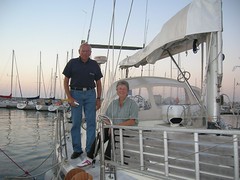 |
| Jan and Tini on Cocon |
We had a lazy day with breakfast in a café and working on the computer. Tini and Jan invited us to Cocon for afternoon tea and cakes as it was Jan’s birthday. We went into the town of Pavoa de Varzim and had a superb dinner for 42 euros in a lovely restaurant
Saturday, 27 October 2007
Train to Oporto
 |
| View of Vila Nova de Gaia from the Cathedral |
FRIDAY 26 OCTOBER 2007
The new metro system runs trains every 20 minutes into Oporto and we got there about lunch time. We had the cheapest Menu del Dia yet – 5 euros for a 3 course meal and drink!
Oporto seems a strange mix of beautiful 15th and 16th century buildings surrounded by alleys of terraced houses, many of them in a poor state of repair. Many of the houses are beautifully tiled on the outside and the walls of Sao Bento Station, Oporto’s central railway station, are decorated by fantastic Azulejos – Painted Ceramic Tiles.
The views from the Cathedral over the red rooftops are amazing. We walked over the Dom Luis I bridge, which was built in 1886 by an assistant of Gustave Eiffel, and had spectacular views of the River Douro, Oporto and Vila Nova de Gaia, where all the port lodges are.
12 years ago Roger, Tony, Jessica and I canoed 250 kilometres on the River Douro from Miranda do Douro on the Spanish border to Oporto, and it was interesting to see where we had landed the canoes when we had arrived. The new Infante Dom Henrique bridge upstream from the Dom Luis I bridge was being built at the time, and we had to time our passage under the bridge as the workmen kept dropping things off it!
Roger had another custard tart, and decided this one was definitely the best so far.
We caught the metro back to Pavoa de Varzim and went to have dinner with Jan and Tini on Cocon.
Viano do Costello to Pavoa de Varzim - 21 Miles
 |
| Viano do Costello Swing Bridge |
We had a leisurely start, as we did not have too far to go, and left about 10.30 after a very cheap breakfast in a Portuguese café – 2.60 euros for two coffees and two croissants! We motor-sailed most of the way, apart from about an hour where we managed to sail.
Pavoa de Varzim is a new, friendly Marina – some of the buildings are still being finished- and seems a better option for visiting Oporto than Leixoes. When we arrived we met Diane, one of Roger’s sailing students, who is delivering a boat to the Canaries.
A café in Lisbon professes to make the best custard tarts in Portugal, so Roger is doing his own research to see if this is true. He had one this morning on the boat, and one this afternoon in a café after we’d been shopping. The one this morning was the best so far.
Jan and Tini, the dutch couple on Cocon are going to spend the winter here and we spent a pleasant evening catching up and having a meal on our boat.
Baiona, Spain to Viano do Costello, Portugal - 35 Miles
It is definitely getting warmer! After an uneventful motor-sail in a flat sea we were welcomed to Portugal by the Marina staff. A swing bridge has been installed at the entrance to the Marina since we were here 3 years ago, so we berthed on the waiting pontoon.
Marina: 14.40 euros
 |
| Entering Portuguese waters |
Portosin to Baiona - 48 Miles
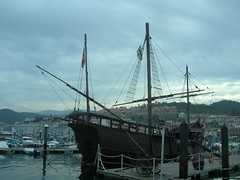 |
| The Pinta |
We had a misty start but will now be heading south for the next 360 miles until we round the tip of Portugal. We need to get the boat to Seville before the bad weather sets in and it was unfortunate that we had to by-pass the beautiful Rias Bajas, but the scenery was superb, particularly as we went past Isla Ons and the Islas Cies. We sailed close to the beach where we had anchored three years ago and noted the contrast between then (hundreds of people in July) and now (totally deserted).
We berthed in the Baiona Yacht Club Marina about 5.30 p.m., passing the replica of the Pinta, which landed in here in 1493 bringing the first news of the New World. After wandering around Baiona, we went to the Parador for an excellent meal.
Marina: 16.45
Diesel: 85.28 (1.09 ltr.)
Camarinas to Ria de Muros, Portosin - 42 Miles
 |
| Portosin |
We left about 9.30 a.m. and rounded Cape Finisterre in a flat sea. We arrived in the first of the Rias Bajas, Ria de Muros and berthed in the Portosin Marina. Marina costs are much cheaper in the low season, so it is possible to stay in Marinas all the time without worrying about the bank balance.
Portosin is a small, friendly marina, but the water was rather dirty and there was a dead cat floating in the water! We had had an excellent meal in the yacht club when we were here three years ago, but it is only open at weekends in the low season, so we found another Italian restaurant.
Marina: 16.40 euros
Sada to Camarinas - 60 Miles
Vivero to Sada - 60 Miles
 |
| Torre de Hercules, La Caruna |
We are getting a little nervous at sailing around Finisterre this late in the year – it’s not called the Costa del Morte for nothing - so we will have to do as much mileage as possible now.
We left Vivera about 8.45 a.m. when it was light in a slight mist and motor-sailed. We were able to sail for a while with a Force 5 behind us and then motor-sailed again when the wind died and the sun came out, arriving about 7 p.m.
We filled up with diesel and later went to find a bar where we could watch the final of the Rugby World Cup, as England were playing South Africa. All the bars had televisions but none seemed to know about the Rugby World Cup, and Barcelona was playing in an important football match, so in the end we went for a meal in an Italian Restaurant.
After the end of September marina prices in this part of the world are a lot cheaper so we intend to avoid anchoring as much as possible from now on, possibly gaining an extra safety factor with more unpredictable weather and the approaching equinox.
Marina: 13.69 euros
Diesel: 92.38 euros (1.09 ltr.)
Back in the UK
Needless to say this was a very sad time for us. My mother appeared to stabilise and then degenerated further, so we both flew back to the UK. Our son and daughter-in-law, Tony and Lisa, flew over from Australia and our daughter from Canada to say goodbye to their Nana. She died peacefully in her sleep on 5 October.
Luarca to Vivero - 50 Miles
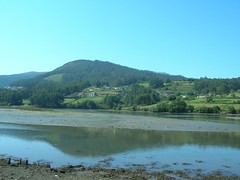 |
| Vivero |
Vivero
Originally uploaded by Yacht Susannah
We waited until about 8.45 a.m. to leave when it got light and because the forecast was not good for the next couple of days we decided to go straight to the Marina in Vivero. We had more fog, thunder and lightening. The storm was so close that we were worried about our electrical equipment, so we put the chart plotter in the oven to protect it (the idea is that the oven functions as a Faraday cage).
Gijon to Luarca - 43 Miles
On Susannah we tend to adopt standard fog procedures; fix position before losing visibility, plot a paper fix every half hour (using dead reckoning and estimated positions – verified by GPS), ensure that our See Me active radar reflector and navigation lights are on. We wear lifejackets, clipping on when the sea is rough, but remaining unclipped in more benign conditions. The theory being that recovering a man overboard in fog would prove very difficult and constitute a greater danger than being hit by a larger vessel and being dragged down with the sinking ship. Sheila monitors the radar and keeps a visual lookout while Roger keeps a visual lookout and blows the foghorn. If sailing we furl the headsail to slow us down and improve all round visibility and, if possible, we navigate to shallow water where there is no chance of being run down by big merchant shipping.
In the event we had thick fog nearly all the way which just lifted a little as we approached the difficult entrance (i.e. rocks and shallows in the approaches) to Luarca. Luckily, we managed to spot the leading marks – just as well as the chart plotter was completely wrong (i.e. the GPS position according to WGS 84 was, of course, accurate, but the electronic cartography – probably based on old local harbour charts was not).
We arrived about 7.30 p.m. and had to lasso one of the buoys, which are metal and close together, and then dinghy ashore with a line to hold the boat away from the other buoys.
Ribadesella to Gijon - 29 Miles
 |
| Boarded by Spanish Customs |
We left Ribadesella about 8.30 a.m. and motored the whole way to Gijon in a flat sea, with a slight swell. Just outside Gijon, we were boarded by some very charming Spanish Customs men.
Marina: 26.50 euros
Diesel: 53.71
Ribadesella
 |
| Ribadesella |
On Friday we went for a lovely walk up the River Sella. The countryside here is stunning with the mountains in the background
Llanes to Ribadesella - 18 Miles
 |
| Ribadesella |
Suances to Llanes - 33 Miles
On Wednesday I found out my mother had had a stroke and I needed to return to the UK, but because of the strong onshore winds, it wasn’t possible to leave Suances until Friday. In view of our previous experience in the river we felt that Suances was not a safe place to leave the boat.
We couldn’t leave the river until just before high tide, so as to minimise the chances of serious breakers across the bar, which was about lunch time, and then motor-sailed the whole way as what little wind there was on the nose. There was quite a swell left over from the strong winds which made me feel a little seasick. Roger managed to catch a good sized mackerel and another fish, which we think is a bream. About 7.30 p.m. we arrived in Llanes, a very small fishing harbour, and there were a lot more small motor boats here than when we were here four years ago, making it very difficult to moor. In the end we rafted against a fishing boat and hoped it wouldn’t be leaving at 4.00 a.m.!
We went for a drink to settle my stomach (always a good excuse!). Llanes is a lively town divided in two by an inlet leading to the inner harbour. There are some beautiful buildings with some lovely architecture. Plenty of restaurants were offering the best value Menu del Dias we have yet seen, so decided to have a meal and not eat the fish Roger had caught. We had a three course meal and bottle of wine for 22 euros for the two of us.
Catch of the Day: 1 Mackerel, 1 Bream
 |
| Llanes Harbour |
Thursday, 6 September 2007
The mother of all tangles!
 |
| The mother of all tangles! |
Perhaps the worst aspect of this experience was that it went on and on all through the night; the wind had strengthened about 6 p.m. on Monday and it wasn't until about 8 a.m. the following day that the wind dropped to a 6 and 7. We had both stayed up all night, playing games and frequent checks on the anchors and position of the boat. I was then able to leave Sheila on anchor watch and catch up on some sleep.
By eight p.m. the wind had moderated to a 4 and we decided to try to re-anchor in mid river away from the wall.
Surprisingly I was easily able to free the kedge warp from the back of the boat and led it to the bow in order to recover the Danforth anchor. This, however, proved extremely difficult; even with the aid of the electric windlass we just could not break it out. We began to suspect that it had fouled the Delta anchor chain so we changed tactics and started to wind in the main chain. An incredible tangle of chain and anchors eventually broke the surface; the kedge and the Bruce together with their respective chains were wrapped around the Delta chain in a serpents’ honeymoon of a tangle. The only way we finally managed to clear this mess was to lean precariously outside the pulpit and unshackle the Danforth (having attached a line to its crown). We were then able to pull the kedge chain clear and slide the anchor out of the knotted chain.
The Bruce proved even more difficult to extract. This was achieved by full fathom coiling, tying the coil (i.e. 100 meters of 12mm anchor plait) and then passing the entire coil over and under the Delta chain, all the while nervously checking that we were still holding. This process involved a few near headfirst entries into the River Suances, but ultimately proved successful. One relatively minor mishap was that unnoticed my barbed fish lure, which I foolishly keep in the kedge warp drum, first attached itself to the kedge warp and then to my thumb. It occurred to me that the tangled anchors had probably acted as an effective angel; weighing down the Delta chain.
Finally, in the gathering twilight we were able to anchor in mid river away from both walls with 30 meters of chain on the Delta and, after re-shackling and seizing the Danforth, 20 meters of kedge warp. We had a curry and a bottle of Rioja – it had never tasted so good and went to bed feeling relatively safe.
Suances and Our Scariest Time Ever!
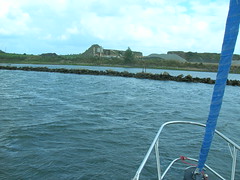 |
| This wall came too close on several occasions! |
The wall that we had a close encounter with!
Originally uploaded by Yacht Susannah
ROGER'S BLOG
The next morning Navtex was forecasting gale force 8 building to 9! However, we had noticed for the last week that the Navtex forecasts tended to be accurate for the offshore sea areas but significantly overestimated wind strength for inshore, coastal sailing. Moreover, the last check on internet weather sites (the previous day) had not indicated anything more than a Force 4 for our part of the Cantabrican coast. At the time the sun was out and the river calm, although the wind was westerly Force 4 to 5, so we decided to stay at anchor in the river and to go ashore in the dinghy.
Suances is a small coastal resort with magnificent beaches, bars and restaurants, but not much else. Nevertheless, we had a pleasant morning; posted some letters, re-provisioned and consumed a Menu del Dia. We went back to the boat and had a siesta only to awake to a Force 6 gusting 7 and the barometer dropping! Sheila decided that we should lash the dinghy on deck and put the outboard on its bracket as at this stage it was occasionally taking off as it was tied to the back of the boat! This we managed without too much difficulty and were sitting in the cockpit discussing whether to let out more chain when we started to drag towards the rocks (i.e. wall). Sheila ran forward and started getting the anchor up while I started the engine with the idea of motoring forward and re-anchoring.
The rocks were close on our port side and the north-westerly wind on our starboard bow – blowing us towards them! I put on full starboard lock and revs in an attempt to drive the bow through the wind and away from the wall. By now the wind had increased to a good Force 8 with stronger gusts and I could not get the bow through the wind. The jagged rocks were getting very close. I changed tactics and put on full port lock and just managed to clear the wall heading off upriver and downwind – the kedge anchor had remained deployed throughout this manoeuvre and was dragging behind us. We had avoided putting the boat on the rocks by only a couple of meters. At least the kedge warp was stretched tight so I had no fears of a prop-wrap at this stage. When we were in mid river I asked Sheila to drop the main delta anchor and let out 30 meters of chain. She looked at me with wide, rabbit caught in the headlights, eyes and said “I’ve cocked up”. Further enquiries elicited the fact that the anchor chain had bunched up under the windlass and was now solidly in a jam. Muttering something about not being able to get the staff, I ran forward and feverishly tugged at the tangled chain. We were drifting at about 6 knots with a good Force 8 behind us on a tangential course for the rocky wall on the opposite side of the river. I realised that I would not be able to free the chain jam in time to stop us coming into fatal contact with the wall so I hastily threw our second anchor, a 40 lb Bruce over and released 30 meters of warp – guessing that this would be short enough to hold us off the wall, but long enough for the anchor to dig in. After a few more minutes of frantic pulling at the tangled chain I managed to free it and dropped the main Delta anchor and let out 30 meters of chain.
The boat had swung head to wind as the Bruce and Delta anchors dug in, trapping the kedge warp under the boat close to the prop; we were now to all intents engineless. We watched nervously as the boat swung within a boat length of the wall and then held. Sheila, a confirmed atheist, prayed (not for the last time that night) and I changed my trousers.
There then followed the most anxious and nerve racking night I have ever spent on a boat. As the wind shifted slightly and the tide turned we swung closer to the wall, at times it appeared that we were within 2 meters! Also as the tide ebbed jagged rocks became visible at the base of the wall. Both of us stayed up all night monitoring the situation. Sheila continuously put waypoints on the chartplotter while I initially used transits. However, we were swinging so dramatically that transits proved of little use and I reverted to simply estimating the distance from the rocks. There was little we could do if we swung any closer, but we discussed two possible courses of action.
The first involved quickly releasing the kedge warp and hoping that it would float clear of the prop so we could use the engine to move away from the wall towards our brace of anchors. We buoyed the end of the kedge warp ready for this form of action, but given the wind (our instruments recorded 43 knots!) I had my doubts about whether we would be able to motor against it and the waves even assuming the warp cleared the stern.
Plan B was to run the engine in neutral, but with high revs in order to supply sufficient power to the electric windlass for us to pull ourselves clear of the wall. This would inevitably shorten our scope and therefore reduce our holding power (not to mention the enormous strain on the drive shaft of the windlass), but would have the advantage of not risking a prop-wrap.
Both of us believed that we would lose the boat, but in an attempt to minimise damage we put all our fenders out. We donned our wet weather gear and lifejackets, put flares in our pockets, rigged the searchlight, tuned the radio to channel 16 and prepared to make a mayday. Although we swung very close to the wall we survived the ebb; the flood seemed to hold us a little further away and we relaxed enough to play Boggle a scrabble type spelling game – the word “die” seemed to crop up quite a lot. Sheila was so distracted by fear, I even won a couple of games! At least we could play with all the cabin lights on and no fear of running down the batteries; the wind generator sounded like it was going to take off as it pumped in 13 amps.
Practical Boatowner magazine runs a series of articles entitled “Learning from Experience”. Well I guess we have learnt to take the worst case weather forecast as gospel.
Santander To Suances - 30 Miles (1008 total)
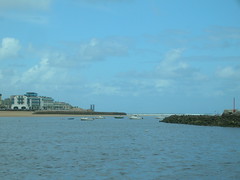 |
| Suances from upriver |
Chris dropped us off at the Marina and we sailed to Suances, about 18 miles away. The wind was on the nose, so we had to tack for the first time since crossing the English Channel.
Bilbao and Guernica
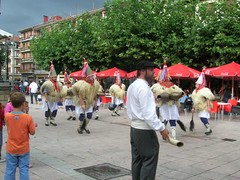 |
| San Roke Festival, Guernica |
We met Tracy and Max at the Guggenheim in Bilbao about lunch time, but the queue was so long we decided to go straight to Guernica.
Guernica’s five day San Roke festival was taking place, and the whole town was in Fiesta mood, with tables laid out along the pavements with food and wine as a variety of entertainments took place, including brass bands, dancing, children’s entertainment and dancing groups. We went to see the national Basque game Pelota, which is rather like squash but played with the bare hand. As we headed towards the car after a meal, there was a fantastic firework display.
The weather improved on Friday so after a late start and long lunch with Max and Tracy (including several bottles of wine) we spent the afternoon on the beach and had a Bar-B-Que at the caravan – our first Bar-B-Que this year!
SANTANDER MARINA: 40 euros a night, free showers
Altamara Caves and Santillana del Mar
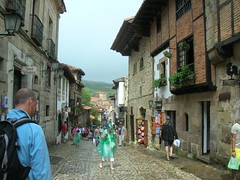 |
| Santillana del Mar |
We set off in Chris’s car for the caves at Altamara, which have some of the oldest and most impressive cave paintings in Europe. The actual caves are only open to researchers as they were being damaged by human breath, but there is a very impressive Museo where there is a full sized recreation of the cave and a fantastic interpretation centre. Tracy, Max and the children joined us and we spent nearly all day there, with a Menu del Dia in the middle. We then went to the medieval village of Santillana del Mar, which has beautiful old buildings but is quite touristy.
Santander
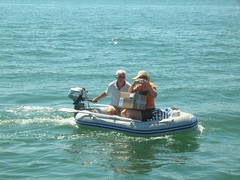 |
| Jane carrying the EPIRB |
Chris, Jane and Tommy joined us on Susannah for lunch, bringing the EPIRB (Emergency Position Indicating Radio Beacon) with them which Roger had ordered about 4 weeks before we left, but had been out of stock.

